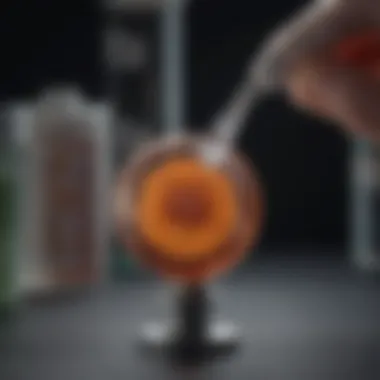Exploring the QuickTiter Lentivirus Titer Kit


Intro
The QuickTiter Lentivirus Titer Kit serves as a pivotal resource in the field of molecular biology, specifically for those utilizing lentiviral vectors in their research. Understanding how to accurately measure the titer of lentiviruses is crucial for various applications, including gene therapy, vaccine development, and functional studies. This kit not only streamlines the titration process but also enhances both the reliability and precision of results.
In this guide, we will delve into several aspects of the QuickTiter Lentivirus Titer Kit. Key elements include its fundamental principles, detailed methodology, practical applications, and troubleshooting strategies. Researchers will also find comparisons to alternative titering methods, helping to clarify its advantages in specific contexts. By facilitating a greater comprehension of the kit’s functionalities, this article aims to empower users to optimize their experiments efficiently.
Research Highlights
Key Findings
The QuickTiter Lentivirus Titer Kit is designed to provide accurate quantification of lentiviral particles in a sample. Key findings from the application of this kit highlight:
- Simplicity: The procedure is straightforward and user-friendly, allowing researchers to obtain results efficiently.
- Sensitivity: It can detect low levels of viral particles, which is essential for various applications, particularly in gene therapy.
- Reliability: Consistent results across experiments establish the kit's reliability, making it a preferred choice among researchers.
- Versatility: The kit is applicable in diverse research settings, from academic laboratories to clinical applications.
Implications and Applications
The implications of using the QuickTiter kit extend across multiple domains of research:
- Gene Therapy: Accurately determining viral titer is crucial for successful gene delivery.
- Vaccine Development: Understanding lentiviral particle concentration can enhance vaccine efficiency in preclinical studies.
- Oncolytic Research: Assessing the efficacy of lentiviral vectors in targeted therapies can be quantified using this kit.
Moreover, the consistent performance of the QuickTiter kit allows for reliable comparisons in experimental designs.
Methodology Overview
Research Design
The design of experiments utilizing the QuickTiter Lentivirus Titer Kit should ensure that all variables are controlled. This facilitates accurate results that can be reproduced in future studies. Specific attention should be paid to defining the objectives of the experimentation to select appropriate parameters.
Experimental Procedures
When using the QuickTiter Lentivirus Titer Kit, the following essential steps are involved:
- Sample Preparation: Begin with isolating the lentiviral sample. This could be from cell culture supernatants where the virus has been produced.
- Dilution: Properly dilute the samples according to the kit’s protocol to achieve optimal concentrations.
- Assay Execution: Follow the provided instructions to perform the assay diligently, ensuring that all reagents are added accurately.
- Data Analysis: Analyze results through the provided detection method, which typically involves quantification of integrated signals.
Attention to detail during the execution of these steps can significantly affect the robustness of results.
Proper use of the QuickTiter kit can greatly reduce variability in lentivirus titer measurements, aiding in accurate study conclusions.
Prolusion to Lentiviruses
Lentiviruses hold a crucial place in the field of molecular biology, particularly in gene therapy. Understanding these viruses is essential for researchers aiming to manipulate gene expression effectively, and for those involved in developing innovative treatments for various diseases.
Lentiviruses are a subset of retroviruses, known for their ability to integrate into the host genome. This integration allows for long-term expression of genes, making them invaluable tools in genetic research and therapy. Their unique properties, such as the capability to infect non-dividing cells, differentiate them from other viral vectors. These characteristics directly fuel their application in therapeutic interventions, including treating genetic disorders and cancers.
In this section, we will delve into the overview of lentiviruses, establishing a foundational understanding of their structure and function. This groundwork will then pave the way for discussing their significant role in gene therapy, emphasizing how knowledge in this area can lead to pivotal advancements in medicine.
Importance of Titer Measurement
Titer measurement plays a critical role in the successful utilization of lentiviruses in various applications, particularly in gene therapy and research. Understanding the concentration of lentiviral particles in a given solution is essential for determining the effectiveness of these vectors in delivering genetic material into target cells. Without precise titer measurements, researchers face significant risks that could jeopardize their experiments.
Definition and Significance of Titer
Titer is defined as the concentration of infectious viral particles within a volume of solution. In the context of lentiviruses, an accurate determination of titer is vital as it directly correlates to the potential efficacy of the viral vector used in experiments. Researchers must understand that the titer impacts both the multiplicity of infection (MOI) and the efficiency of gene transfer.


The significance of measuring titer extends beyond mere quantification. Strong titer values are crucial for experimental reproducibility. When peers can follow a protocol and achieve similar outcomes, it enhances the credibility of findings. Therefore, precise titer definitions foster reliability in scientific communication.
Quantifying titer allows researchers to:
- Optimize experimental conditions: By knowing the titer, researchers can adjust the amount of virus used in their experiments, leading to better outcomes.
- Establish baselines: Knowing the baseline titer helps in evaluating the effects of genetic modifications or treatments.
- Enhance safety: With accurate measurements, researchers minimize the risk of unintended consequences that may arise from using incorrect viral loads.
Applications of Lentivirus Titering
The applications of lentivirus titering are extensive and critical for pushing the boundaries of genetic research. Lentiviral vectors are increasingly used to study gene functions, model diseases, and develop gene therapies.
Some common applications include:
- Gene Therapy Development: Precise titer measurements enable researchers to determine the optimal dosage of therapeutic genes for clinical trials.
- Functional Genomics Studies: Accurate titer values are essential for assessing the impact of specific genes on cellular functions.
- Regenerative Medicine: In stem cell therapy, knowing the correct titer can facilitate effective gene delivery and enhance cell reprogramming.
- Vaccine Research: Lentiviral vectors can be pivotal in developing vaccines against various pathogens. Proper titering ensures effective immune responses.
"Titer measurement is not an obstacle, but a pivotal component of experimental success in genetic research."
This dedication to understanding and accurately measuring titer sets the stage for innovations and breakthroughs in the field.
Understanding QuickTiter Technology
Understanding the technology behind the QuickTiter Lentivirus Titer Kit is vital for researchers in the field of virology and gene therapy. This section elaborates on the primary advantages and components of the QuickTiter Kit, highlighting its significance in accurately measuring lentivirus titers.
The QuickTiter Advantage
The QuickTiter Lentivirus Titer Kit represents a notable advancement in the realm of titer measurement. Its significance lies in several key features:
- Ease of Use: The kit's user-friendly design allows researchers, regardless of their experience level, to efficiently measure lentivirus titers. Instructions are clear and protocols straightforward, minimizing time spent on troubleshooting.
- Rapid Results: The QuickTiter kit is specifically designed to produce results quickly. This rapid output is crucial for researchers who need timely data to make decisions in experimental design and execution.
- Sensitivity and Specificity: With a robust detection system, the QuickTiter Kit ensures high sensitivity in detecting low levels of lentivirus. This feature is particularly important when working with diluted samples, common in various experimental settings.
In summary, the QuickTiter's various advantages simplify the process of titer measurement, rendering it a reliable choice for many laboratory settings.
Components of the QuickTiter Kit
The effectiveness of the QuickTiter Lentivirus Titer Kit can largely be attributed to its thoughtfully assembled components. Each part plays a specific role in ensuring accurate and efficient performance:
- Lentivirus Standard: This component serves as a reference point, giving researchers a known quantity against which they can compare their samples.
- Detection Reagents: These reagents are crucial for identifying the presence of lentiviral particles. They work by binding to specific viral proteins, making measurement easier and more reliable.
- Control Samples: Included for ensuring the accuracy of test results, control samples allow researchers to verify the functionality of their assays, preventing any erroneous conclusions.
- Cell Cultures: Many assays require the cultivation of cells, making cell lines an integral part of the kit. Proper preparation of these cultures is essential for successful titer assessments.
- User Manual: A comprehensive guide that outlines all steps for optimal usage. It aids researchers in navigating the procedures with clarity.
Step-by-Step Protocol for Using the QuickTiter Kit
Understanding the step-by-step protocol for using the QuickTiter kit is essential for any researcher dealing with lentiviruses. This protocol not only streamlines the process of titer measurement but also ensures accuracy and reproducibility. By following the steps carefully, researchers can efficiently assess the productivity of their lentivirus preparations, which is crucial for various experimental setups.
Preparation of Samples
The foundation of successful titer testing lies in proper sample preparation. Before beginning the assay, it is vital to determine the appropriate concentration of lentivirus for testing. Use culture supernatants from transduced cells or viral stocks. Ensure that your samples are properly clarified. Centrifuge them at high speed to remove debris. This reduces any non-specific signals that can interfere with the results.
Next, diluting the samples is necessary. Depending on the expected titer range, prepare serial dilutions in a suitable buffer, often phosphate-buffered saline (PBS). Proper dilution not only enhances the detection limits but also maximizes the sensitivity of the assay. Make sure to label all tubes clearly to avoid any mix-up later in the process.
Assay Procedure Overview
With samples ready, you can now move to the assay procedure. The QuickTiter kit typically includes all required reagents, which makes it user-friendly. Begin by adding the well-diluted samples to the appropriate wells of a multi-well plate. It is important to include controls in your setup. Positive controls ensure the assay is functioning well, while negative controls can help identify any background signal.
After adding samples, incubate the plate at the recommended temperature and time. This step is critical as optimal conditions allow for the best interaction between the virus and the target cells. After incubation, the addition of detection reagents follows. Proceed with care to avoid generating any artifacts.
Data Collection and Analysis
Once the assay is complete, the next step is data collection and analysis. The QuickTiter kit usually provides guidelines for interpreting the resulting data, which simplifies the process. Collect the data by measuring fluorescence or colorimetric signals, according to the specific protocol of the kit.


After data collection, analyzing the results is key. Use the dilution factors to calculate the titer of your lentivirus. It is also worthwhile to visualize the data, possibly using software tools, for a more comprehensive understanding. Keep in mind the mean titer values while accounting for standard deviations, as this aids in assessing the reliability of your results.
A critical aspect when analyzing data is to consider the context of the experiment. Compare your titer data to benchmarks or control groups to gauge the effectiveness of your lentivirus preparation.
Overall, meticulous attention to each of these steps will lead to reliable and valid titer measurements.
Interpreting QuickTiter Results
Interpreting the results from the QuickTiter Lentivirus Titer Kit is crucial for understanding the viral concentration and its efficacy in various applications. Accurate titering provides insights into not only the quantity of lentivirus present but also the quality of the preparations used in experiments. By grasping the titer values reported by the kit, researchers can make informed decisions about transduction efficiencies, suitable dosing in experiments, and ultimately, the potential success of gene therapy applications.
Understanding Titer Values
Titer values indicate the amount of infectious virus present in a sample and are expressed in terms of infectious units per milliliter (IU/mL). A higher titer means more viral particles are available, leading to greater transgene delivery. Here are essential points about titer values:
- Importance of Quantification: Knowing the titer helps in comparing the effectiveness of different viral preparations.
- Standardization: Consistent titer measurements allow for better reproducibility of experimental results across different labs.
- Interpretation: A low titer might indicate issues with viral production, while a high titer suggests successful culture conditions.
To enhance comprehension, researchers often visualize titer values using standardized curves. This method enhances accuracy during experimental planning, minimizing potential variances rooted in differing viral concentrations.
Factors Influencing Titer Measurements
Several factors can greatly affect titer measurements. Being aware of these variables can help researchers troubleshoot issues effectively. Some influential elements include:
- Cell Line Used: Different cell lines may have varying transduction efficiencies. Selection of an appropriate cell line is essential.
- Assay Conditions: Deviations in temperature, incubation time, and medium may lead to inconsistent results.
- Reagent Quality: The freshness and stability of reagents in the QuickTiter kit are vital for reliable outcomes.
- Sample Handling: Improper handling, such as freeze-thaw cycles or contamination, can compromise titer determination.
Understanding these factors is imperative for obtaining reliable titer results and enhancing experimental design.
Troubleshooting Common Issues
In any scientific procedure, unexpected results can be a source of frustration and confusion. When working with the QuickTiter Lentivirus Titer Kit, understanding the common issues that may arise is crucial for achieving accurate and reliable results. This section outlines key troubleshooting areas, helping researchers identify and resolve potential problems efficiently. Addressing these challenges not only enhances the reliability of your experiment but also saves time and resources.
Non-specific Results
Non-specific results can complicate the interpretation of lentivirus titer measurements. Such results are characterized by a lack of correlation between the observed readings and the actual titer value. These discrepancies may arise from various sources, including the presence of contaminants or improper assay conditions. Researchers must first ensure that samples are free from any foreign substances that could interfere with the assay.
Furthermore, it is critical to review the assay procedure for adherence to recommended protocols. Temperature fluctuations during incubation or prolonged exposure to light can also lead to unreliable results. Conducting control experiments with known titer values can help confirm the specificity of the assay being used.
Low Titer Readings
Low titer readings may indicate an insufficient quantity of virus in the sample or issues with detection methods. It’s essential to verify sample dilution protocols to confirm that they align with the necessary parameters for accurate measurement. Sometimes, low titer results can simply reflect a less effective viral production system.
Researchers should check the transfection efficiency if the lentiviral vector is being produced in vitro. Adjustments in the transfection protocol or the use of optimized reagents can significantly enhance the yield of viral particles. Additionally, ensuring that the cells used for infection are optimal for lentivirus entry can influence the detected titer.
Reagent Stability Considerations
The stability of reagents used in the QuickTiter kit is another important factor to consider. Over time, reagents may degrade, leading to inconsistent results. It is advisable to follow the manufacturer's guidance on storage conditions. For best results, reagents should be aliquoted and stored at appropriate temperatures to maintain their viability.
Moreover, researchers should periodically check reagent expiration dates and observe any changes in appearance or performance. Conducting stability tests can help identify any potential compromises to the assay's reliability. Keeping a detailed log of reagent preparation and usage can also assist in identifying any correlations between reagent instability and experimental outcomes.
Ensuring the quality of reagents and proper assay conditions is essential for reliable titer measurements.
Overall, addressing these common issues with the QuickTiter Lentivirus Titer Kit will foster a deeper understanding of titer measurement and improve the accuracy of lentiviral research.
Comparative Analysis with Other Titering Methods


Traditional Methods vs. QuickTiter
When comparing traditional titering methods with the QuickTiter kit, it is essential to understand the fundamental differences in approach and outcome. Traditional methods often involve complicated procedures, such as measuring viral loads through plaque assays or focus-forming units. These methods can be labor-intensive, requiring extensive hands-on time and expertise in cell culture techniques.
In contrast, the QuickTiter kit streamlines the process. It provides a more straightforward, faster approach without sacrificing accuracy. One of the primary benefits of using QuickTiter is the ability to achieve consistent results with minimal variability. Researchers are increasingly recognizing the importance of efficiency as they work under tight timelines or limited resources.
- Efficiency: QuickTiter reduces hands-on time significantly compared to traditional methods.
- Accuracy: Many users report that QuickTiter delivers results that are comparable to or even superior to traditional methods.
- User-Friendliness: The kit requires less specialized knowledge, making it accessible to a broader range of scientists.
However, an essential consideration is that traditional methods may still have their place. They can provide additional insights into viral behavior and infection dynamics that might not be captured through QuickTiter. Therefore, selecting the best method may depend on the specific goals of the research. Those looking for rapid results may prefer QuickTiter, but researchers interested in more in-depth analysis may still benefit from traditional practices.
Integrating QuickTiter in Current Practices
Integrating the QuickTiter method into existing research practices is not merely a matter of swapping out one protocol for another. Researchers must consider how this technique fits within their experimental framework. The adoption of QuickTiter depends on various factors, such as the nature of the study, the viral vector being used, and the existing infrastructure within the laboratory.
Many laboratories can seamlessly incorporate QuickTiter into their workflows due to its versatility. Here are a few considerations for integration:
- Training and Familiarization: While QuickTiter is user-friendly, training team members is crucial for optimal implementation. A proper understanding of the kit's components and protocol can lead to better outcomes.
- Customizing Protocols: Depending on research demands, researchers might need to adapt the QuickTiter protocol slightly to align with their experimental designs. This flexibility is one of the kit's strengths.
- Evaluating Results: Post-integration, a continuous evaluation of data will help identify any discrepancies or improvements in results. This evaluation may guide adjustments in usage or reveal potential advantages over previous methods.
Utilizing the QuickTiter kit can enhance research capabilities, particularly when integrated thoughtfully into existing methodologies. The future looks promising as researchers continue to discover the optimal use of QuickTiter in various experimental settings.
"Research is an iterative process. Understanding how to effectively integrate new tools like QuickTiter can significantly advance our understanding of lentivirus dynamics."
As the field of gene therapy evolves, the integration of rapid and reliable titering methods will support innovative research and therapeutic developments.
Future Directions in Lentiviral Titering
The field of lentiviral titering is at a pivotal moment, where technology is rapidly evolving. This section aims to explore future directions in this area, providing insights into potential advancements that can streamline both research and practical applications. As scientists continue to investigate the versatile functionalities of lentiviruses, it is crucial to embrace the innovations that can enhance accuracy, efficiency, and usability. The future promises enhanced methodologies that will contribute to improved data quality and expanded applications across various research domains.
Technological Advancements
Recent advancements in technology are poised to greatly impact how lentiviral titering is conducted. It's critical to consider the implications of these advancements on research outcomes.
- Automation: Automation in laboratories is growing. This shift can improve the consistency of titer measurements. Automated systems reduce human error, allowing for high-throughput analyses that save time and resources.
- Real-Time Monitoring: New devices enable real-time monitoring of viral titering processes. This can allow researchers to obtain immediate feedback on experimental conditions and troubleshoot issues promptly.
- Digital Imaging and Analysis: Improvements in imaging technology allow for more precise quantification of viral particles. Advanced imaging techniques can capture detailed data, assisting researchers in obtaining a clearer understanding of titer results.
- Integration with AI: Artificial intelligence is becoming a useful tool for analyzing complex data sets. AI algorithms can quickly process large volumes of data, predicting trends and optimizing protocols based on past outcomes.
Incorporating these advancements will likely lead to more reliable results in lentivirus research.
Potential Research Applications
The advancements in lentiviral titering do not just improve methodologies; they also open new avenues for research. Understanding these potential applications can aid researchers in envisioning the broader impact of their work.
- Gene Therapy: Improved titering methods can enhance the development of gene therapies. Accurate titer measurements ensure the right doses of lentiviral vectors are delivered, improving treatment efficacy while minimizing adverse effects.
- Vaccine Development: Lentiviruses can be used in vaccine formulations. Enhanced titering techniques can support the evaluation of viral loads in vaccine candidates, leading to better candidate selections.
- Oncology Research: As lentiviruses are explored as tools for targeted cancer therapies, accurate titering becomes essential. It can help determine optimal dosing in preclinical models, influencing trial designs for patient therapies.
- Biomedical Research: The precise quantification of viral vectors can facilitate a variety of studies, from basic microbiology to cutting-edge biotechnology. Strong titering techniques can assist in mapping viral dynamics and mechanisms of action.
The future of lentiviral titering holds great promise, as technological advancements pave the way for new research applications. Embracing these changes will not only enhance experimental efficacy but also contribute to the overall progress in the field of genomics and molecular biology.
The End
The Conclusion section of this article is crucial for understanding the overall implications of using the QuickTiter Lentivirus Titer Kit in research settings. This concise wrap-up emphasizes the importance of accurate titer measurement in the context of gene therapy and related studies. It brings together all key findings discussed throughout the article, which helps the reader synthesize the information presented.
Summary of Key Findings
In summary, the QuickTiter Lentivirus Titer Kit stands out due to its ease of use and reliability in titering lentiviral vectors. The kit simplifies the measurement process, compared to traditional methods, making it accessible to a broader range of researchers. Its ability to deliver consistent titer results is essential for optimizing experimental conditions in gene therapy research.
Key points about the QuickTiter kit include:
- Fast and efficient protocols: The methodology allows for quick results, minimizing time spent in the lab.
- Accuracy in measurement: Reliable titer results are fundamental in ensuring successful gene delivery and expression.
- Versatile applications: The kit is applicable across various experimental contexts, extending its usefulness to a diverse array of research areas.
Final Thoughts on QuickTiter Utilization
When considering the utilization of the QuickTiter Lentivirus Titer Kit, researchers should weigh the benefits of its streamlined process against the specific needs of their experimental goals. The user-friendly design facilitates quick learning curves for new users, while experienced researchers may appreciate the consistency it brings to their workflows.
While the QuickTiter kit presents numerous advantages, researchers must also remain aware of factors that can influence the results. Proper sample preparation and adherence to the manufacturer’s protocols are key for obtaining the most accurate measurements.



